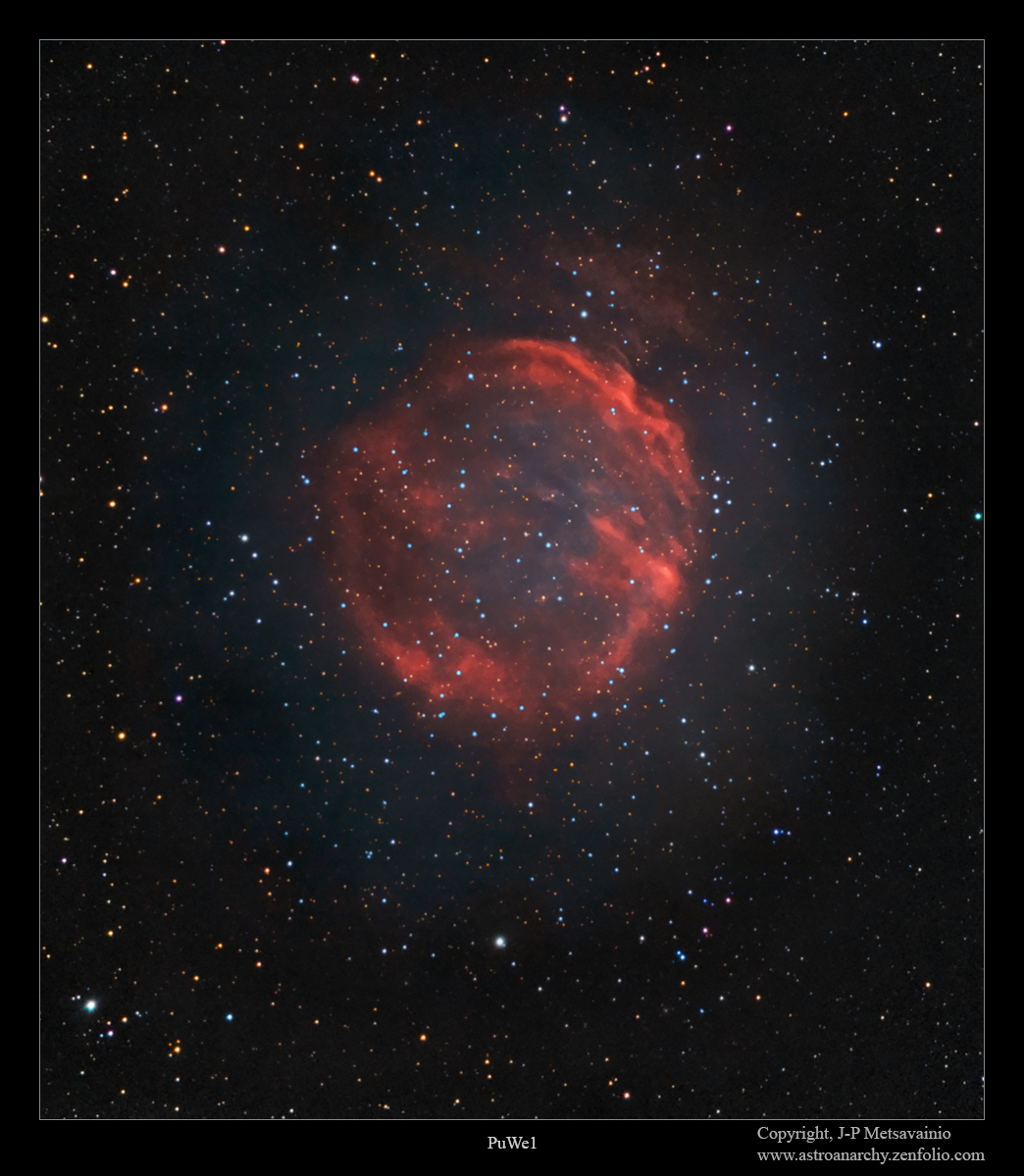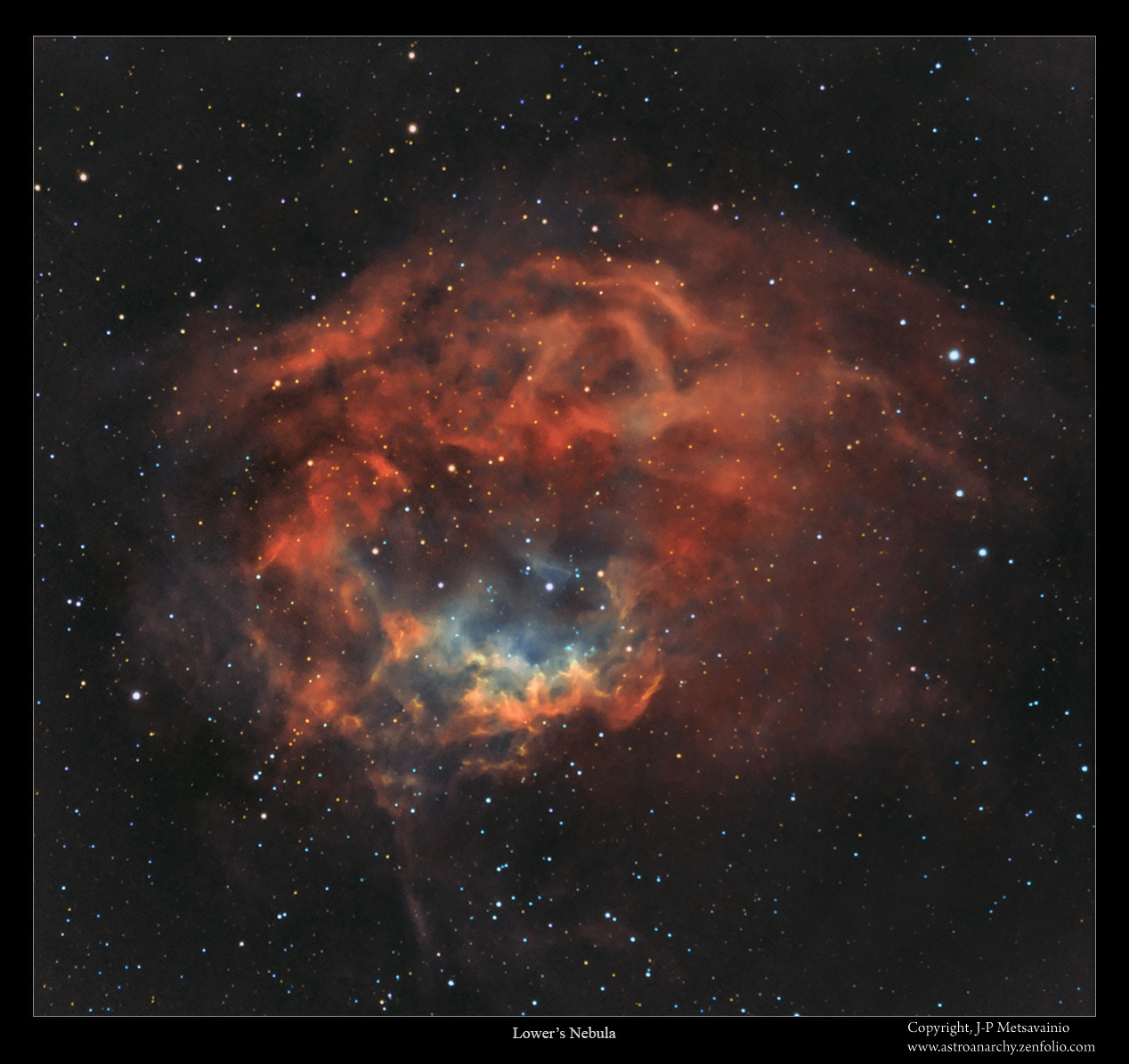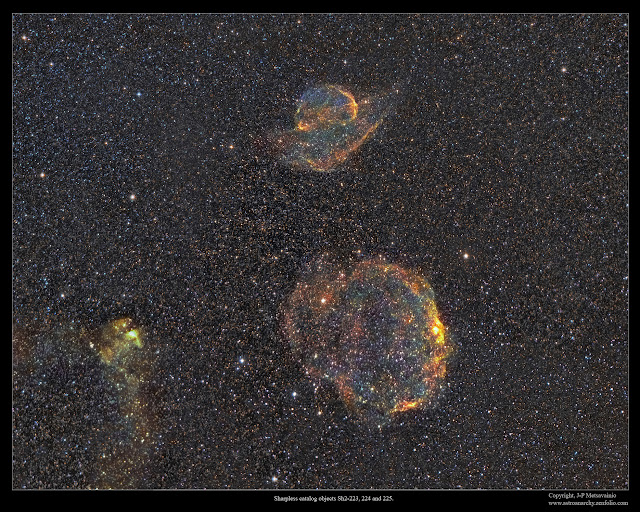COPYRIGHT, PLEASE NOTE
All the material on this website is copyrighted to J-P Metsavainio, if not otherwise stated. Any content on this website may not be reproduced without the author’s permission.
Have a visit in my portfolio
PORTFOLIO:https://astroanarchy.zenfolio.com/
Tuesday, April 5, 2016
The end, all of my photos from the Winter season 2015-2016
The season was very cloudy as usually. We had many months a solid cloud cover this winter and clear nights just now and then. The good side is, that I have been forced to develop new imaging and processing methods to be able to finalise maximum number of photos. The "Tone mapping" method and a new unpublished "VARES" (Variable Resolution imaging method) are very powerful tools for astrophotography. I'll publish the VARES.method in a year or so, after I have tested it well enough.
A poster format collection from all of my photos, Spring season 2016
Please, click for a large image, 2200 x 3000 pixels, ~4MB
Autumn season 2015
Please, click for a large image, 2200 x 2500 pixels, ~4MB
Photos from the Winter season 2015 - 2016 in chronological order, oldest first
Autumn season 2015
Pickering's Triangle, http://www.astroanarchy.blogspot.fi/2015/09/pickerings-triangle-my-first-light-for.html (NASA APOD)
Elephant's Trunk Nebula, http://www.astroanarchy.blogspot.fi/2015/10/elephants-trunk-nebula-in-ic-1396.html
Witch Broom Nebula, http://www.astroanarchy.blogspot.fi/2015/10/a-new-image-witchs-broom-nebula.html
Filaments of Cygnus, http://astroanarchy.blogspot.fi/2015/11/filaments-of-cygnus.html
Filaments of Cygnus, http://www.astroanarchy.blogspot.fi/2015/10/filaments-of-cygnus-project-continues.html
Filaments of Cygnus, http://www.astroanarchy.blogspot.fi/2015/10/filaments-of-cygnus-ring-of-fire.html
Filaments of Cygnus, http://www.astroanarchy.blogspot.fi/2015/11/more-filaments-of-cygnus-and-couple-of.html
Filaments of Cygnus, http://www.astroanarchy.blogspot.fi/2015/10/filaments-of-western-cygnus.html
Detail of NGC 1499, http://astroanarchy.blogspot.fi/2016/01/ngc-1499-california-nebula.html
Filaments of central Cygnus, http://astroanarchy.blogspot.fi/2016/01/my-first-photo-for-year-2016-filaments.html
Supernova remnant CTB1, http://astroanarchy.blogspot.fi/2016/01/abell-85-ctb1-dim-galactic-supernova.html
Supernova remnant Sharpless 224, http://astroanarchy.blogspot.fi/2016/03/supernova-remnant-sharpless-224-in.html
Planetary Nebula PuWe1, http://astroanarchy.blogspot.fi/2016/04/the-last-imaging-project-of-season-puwe1.html
All photos above have been taken with this setup
My humble thanks to the supporters, they made my work possible once again!
-
All companies are offering the first class products and service!
- Mount, 10-micron 1000
- Optics, Celestron Edge HD 1100
- Camera, Apogee U16 D09 with KAF16803 chip, 4096x4096 9 microns pixels, 36,8x36,8mm
- Filter Wheel, Apogee, seven square slots 50x50mm
- Focuser, FeatherTouch with MicroTouch control unit
- Heater, Dew Buster
- Active Optics Unit, SXV AO LF from Starlight Xpress + OAG
- Guider, an ultra sensitive Lodestar X2, also from Starlight Xpress
- Focal Reducer, Celestron reducer 0.7 for Edge 1100
- Finder, Telrad
- Filters, Astrodon, H-alpha 5nm, O-III 3nm, S-II 3nm. R, G, B and L
Some highlights from the season past
- Exhibition in Mikkeli Center of Photography
- I was a one of the speakers in Panhellenic Conference of Astronomy in Sparta, Greece

Dr.Ioannis - Hugh Seiradakis Professor of the Physics Department of AUTH
J-P Metsavainio Finnish astrophotographer
J-P Metsavainio Finnish astrophotographer
The Dr.Fiori Anastasia Metallinou is an associate of the Institute of Astronomy, Astrophysics, Space Applications and Remote Sensing of the National Observatory of Athens.
Dr.Kosmas gauze is Lecturer of the Department of Astrophysics, Astronomy and Mechanics, University of Athens
- Concert, thousand year old vocal music with my astronomical photos
Two concerts with two vocal ensemble Cappella pro Vocale from Oulu and Punctum from Rovaniemi. Thousand year old vocal music with my astronomical photos turned to be a timeless combination.
My imageshow was matched with music and it was projected on the walls and ceiling with four power projectors. Concert took place in two places, first one was in Oulu, Finland at the Church of St Thomas, the second one took place in Rovaniemi in Northern Finland at the Chapel of Korkalovaara.
Concert in Rovaniemi, Chapel of Korkalovaara at Polar Circle (Image is taken during rehearsal)
Concert in my hometown Oulu at Church of St Thomas
Concert in my hometown Oulu at Church of St Thomas
Concert in Rovaniemi, Chapel of Korkalovaara at Polar Circle (Image is taken during rehearsal)
Concert in Rovaniemi, Chapel of Korkalovaara at Polar Circle (Image is taken during rehearsal)
Monday, April 4, 2016
The last imaging project of the season, PuWe1
This is my last imaging project of the Spring season 2016. We'll lose astronomical darkness day after tomorrow for about six months due to high latitude, 65N.
PuWe1 is a very large and diffused planetary nebula in constellation Lynx. I think this is the first ever three channel narrowband image of it. This planetary nebula is extremely dim, I added single twenty minutes frames at end of the post to demonstrate, how little information there really is.
The data is collected between 16. February and 3. April. Total exposure time is around 23h. To boost the sensitivity of the camera, exposures are mostly shot binned between bin 2x2 and bin 10x10.
Final data is combined so, that high signal noise components, mostly stars, are from bin 1x1 data. Low signal elements are combined from heavily binned data.
There is a hint of outer halo visible in this image. It's extremely dim, especially with the focal length used. I have shot this object with much shorter focal length at Spring 2011. That was the first time I noticed the possible outer structure in this planetary nebula. I like to have this confirmed by some other imager. I will continue this imaging project at Spring season 2017.
There is a hint of outer halo visible in this image. It's extremely dim, especially with the focal length used. I have shot this object with much shorter focal length at Spring 2011. That was the first time I noticed the possible outer structure in this planetary nebula. I like to have this confirmed by some other imager. I will continue this imaging project at Spring season 2017.
PuWe1, planetary nebula in Lynx
Ra 06h 19m 34s Dec +55° 36′ 42"
The photo is in mapped colors from the light emitted by an ionized elements,
red=sulfur, green=hydrogen and blue=oxygen.
PuWe1 in visual colors
Click for a large image
Natural color composition from the emission of ionized elements, R=80%Hydrogen+20%Sulfur, G=100%Oxygen and B=85%Oxygen+15%Hydrogen to compensate otherwise missing H-beta emission. This composition is very close to a visual spectrum.
INFO
PuWe1, (Purgathofer-Weinberger 1, PNG 158.9 + 17.8, PK 158+17.1) is a large circular Planetary Nebula in the constellation of Lynx. It has an apparent diameter of 20', without an outer halo seen in the image.
Messier 27 compared to PuWe1
Click for a large image
Note. An apparent size of the full Moon is marked as a white circle atop of the image.
Technical details
Processing work flow
Image acquisition, MaxiDL v5.07.
Stacked and calibrated in CCDStack2.
Deconvolution with a CCDStack2 Positive Constraint, 21 iterations, added at 25% weight
Color combine in PS CS3
Levels and curves in PS CS3.
Imaging optics
Celestron Edge HD 1100 @ f7 with 0,7 focal reducer for Edge HD 1100 telescope
Canon EF 200mm f1.8 camera optics (For S-II and O-III channels)
Mount
10-micron 1000
Meade LX200 GPS 12" (For S-II and O-III channels)
Cameras and filters
Imaging camera Apogee Alta U16 and Apogee seven slot filter wheel
Guider camera, Lodestar x2 and SXV-AOL
QHY9 (For S-II and O-III channels)
QHY9 (For S-II and O-III channels)
Astrodon filter, 5 nm H-alpha
Baader filter, 8,5 nm O-III
Baader filter, 8 nm S-II
Exposure times
H-alpha, 30 x 1200s binned 2x2 =10h
O-III, 21 x 1200s binned 2x2 = 7h
O-III, 12 x 900s binned 10x10 = 3h
O-III, 12 x 900s binned 10x10 = 3h
S-II, 9 x 1200s binned 10x10 = 3h
Total 23h
A single uncropped, calibrated and stretched 20 min. H-alpha frame as it comes from the camera, the data is binned 2x2
A single uncropped, calibrated and stretched 20 min. O-III frame as it comes from the camera, the data is binned 2x2
Thursday, March 31, 2016
The Lower's nebula in visual colors
I have published a photo of the Lower's Nebula in mapped colors about a week ago. Now I'm publishing the same nebula as a visual natural color version. Narrowband emission from hydrogen, oxygen and sulfur (H-a, O-III and S-II) are combined so, that the result is very close to a visual spectrum. Since the ionized hydrogen emits red light and it usually dominates nebulae, images are more or less red. Blueish hues are from ionized oxygen, O-III. Sulfur, S-II, emits red too and it get mixed to a hydrogen emission visually.
Lower's Nebula
Click for a large image
Image is in natural colors from the light emitted by an ionized elements, sulfur, hydrogen and oxygen.
INFO
The Sh2-261 (Sharpless 261), also known as the Lower's Nebula, is a faint region of doubly ionized hydrogen. Its apparent dimension is about 50 arcminutes in East-West direction and 30 arcminutes in North-South. So, it has an apparent size about twice the full Moon diameter. Of course the real size of the nebula is much larger! But we have no information about the distance of this hydrogen cloud, so we are not able to determine how large it is. (Source, www.skyfactory.org)
Technical details
Processing work flow
Image acquisition, MaxiDL v5.07.
Stacked and calibrated in CCDStack2.
Deconvolution with a CCDStack2 Positive Constraint, 21 iterations, added at 25% weight
Color combine in PS CS3
Levels and curves in PS CS3.
Imaging optics
Celestron Edge HD 1100 @ f7 with 0,7 focal reducer for Edge HD 1100 telescope
Mount
10-micron 1000
Cameras and filters
Imaging camera Apogee Alta U16 and Apogee seven slot filter wheel
Guider camera, Lodestar x2 and SXV-AOL
Astrodon filter, 5nm H-alpha
Astrodon filter, 3nm O-III
Astrodon filter, 3nm S-II
Exposure times
H-alpha, 9 x 1200s =3h
O-III, 3 x 1200s binned = 1h
S-II, 3 x 1200s binned = 1h
Total 5h
A single uncropped, calibrated and stretched 20 min. H-alpha frame as it comes from the camera

Labels:
Narrowband color images,
nebula
Wednesday, March 30, 2016
Supernova remnant Sharpless 224 in auriga
The imaging season up here 65N starts to be over soon, in a week we'll be out of astronomical darkness for about six months. This photo of dim supernova remnant in constellation Auriga is one of the last images for the Spring season 2016.
Sharpless 224 in visual colorsClick for a large image
Natural color composition from the emission of ionized elements, R=80%Hydrogen+20%Sulfur, G=100%Oxygen and B=85%Oxygen+15%Hydrogen to compensate otherwise missing H-beta emission. This composition is very close to a visual spectrum.
Click for a large image
The photo is in mapped colors from the light emitted by an ionized elements,
red=sulfur, green=hydrogen and blue=oxygen.
INFO
Supernova remnant Sharpless 224, Sh2-224, locates in constellation Auriga at distance of about 14700 light years. It has an apparent size about 60 arc minutes, the real size is around 235 light years. This is a very dim target and lots of exposure time is needed to reveal any details out of it. Beside Hydrogen alpha, there are also weak emission from ionized oxygen, O-III, and ionized sulfur, S-II.
Wide field images of the area
Click for a large photo, 1800 x 1500 pixels, 3MB
This photo is from March 2009. QHY9 astrocamera, Canon EF 200mm f1.8 camera lens and Baader narrowband filters. Total exposure time is around 15h. Original photo with technical details can be seen HERE
12 panel mosaic of constellation Auriga
Click for a large photo, 2600 x 1200 pixels, 5MB
Mosaic image is from March 2012. This panoramic mosaic spans about 21 degrees of sky.
That's 42 full Moons side by side. QHY9 astrocamera, Canon EF 200mm f1.8 camera lens and Baader narrowband filters. Total exposure time is around 70h. Original photo with technical details can be seen HERE
Technical details
Processing work flow
Image acquisition, MaxiDL v5.07.
Stacked and calibrated in CCDStack2.
Deconvolution with a CCDStack2 Positive Constraint, 21 iterations, added at 25% weight
Color combine in PS CS3
Levels and curves in PS CS3.
Imaging optics
Celestron Edge HD 1100 @ f7 with 0,7 focal reducer for Edge HD 1100 telescope
Canon EF 200mm f1.8 camera optics (For S-II and O-III channels)
Mount
10-micron 1000
Meade LX200 GPS 12" (For S-II and O-III channels)
Cameras and filters
Imaging camera Apogee Alta U16 and Apogee seven slot filter wheel
Guider camera, Lodestar x2 and SXV-AOL
QHY9 (For S-II and O-III channels)
QHY9 (For S-II and O-III channels)
Astrodon filter, 5 nm H-alpha
Baader filter, 8,5 nm O-III
Baader filter, 8 nm S-II
Exposure times
H-alpha, 24 x 1200s binned 2x2 =8h
O-III, 12 x 600s binned 4x4 = 2h (Year 2009)
S-II, 12 x 600s binned 4x4 = 2h (Year 2009)
Total 12h
A single uncropped, calibrated and stretched 20 min. H-alpha frame as it comes from the camera
Labels:
Narrowband color images,
nebula
Subscribe to:
Posts (Atom)



































